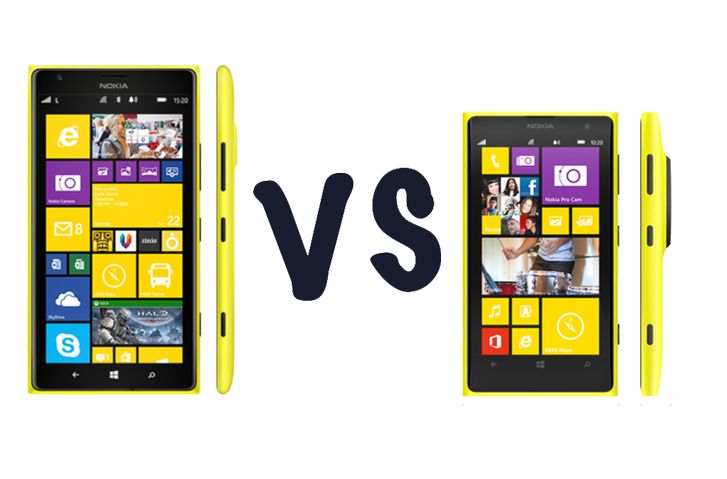Nokia has officially announced the much-rumoured Nokia Lumia 1520, bringing a phablet device to Nokia's line-up of Windows Phones.
But where does that leave the Nokia Lumia 1020, the cameraphone darling of the smartphone world? Does this new monster tablet rudely push the 40-megapixel handset aside to become the focus of Windows Phone's attention?
We've drawn them up together to determine exactly what the difference is.
The Lumia 1520 is bigger
The Lumia 1520 is bigger than the Lumia 1020, coming in at 162.8 x 85.4 x 8.7mm compared to the 1020's 130.4 x 71.4 x 10.4mm. The 1520 also weighs more, hitting the scales at 209g, while the 1020 is 158g.
This doesn't come as too much of a surprise, given that you get a 6-inch display with the 1520 compared to the 4.5-inch screen found on the 1020, but if size matters to you, there's a hefty difference here.
The Lumia 1520 has a sharper display
The Lumia 1020's 4.5-inch ClearBlack AMOLED display is brilliant, featuring a 1280 x 768 pixel resolution and a pixel density of 334ppi, but the 1520's display is better.
The Lumia 1520 has a ClearBlack display too, but it is LCD rather than AMOLED. It comes with a resolution of 1920 x 1080 367ppi, spread across 6 inches. It isn't just big and dumb: it will give you finer detail to go with that bigger Windows Phone experience.
Camera: PureView heaven
In terms of the camera, the 1020 has a higher resolution sensor than the 1520 featuring a 41-megapixel rear snapper with f/2.2 aperture, compared to the 20-megapixel sensor and f/2.4 aperture found on the 1520.
Both devices feature Zeiss optics and optical image stabilisation but they have different flashes, with the 1020 featuring a Xenon flash and the 1520 a dual-LED flash.
The 1020 has high-resolution 3x zoom, while the 1520 has high-resolution 2x zoom, which comes down to the difference in sensor. We strongly suspect that together they will be a phenomenal photography pair, whichever you choose.
The Lumia 1520 is faster and will last longer
The Lumia 1520 comes with a 3400mAh battery with built-in Qi wireless charging which is a huge upgrade in terms of capacity from the 1020's 2000mAh. You can get wireless charging on the 1020 too, but it isn't built in so you will need the accessory cover.
According to Nokia, the 1520 will give you up to 25.1 hours of 3G talk time and up to 10.8 hours of video playback, while the 1020 promises up to 13.3 hours of 3G talk time and up to 6.8 hours of video playback. Size really makes a difference when it comes to battery life.
You'll also get a faster device with the 1520 which comes with the latest quad-core 2.2GHz Qualcomm Snapdragon 800 processor, compared to the 1020's dual-core 1.5GHz Qualcomm Snapdragon S4. Both devices come with 2GB of RAM.
Better storage capability on the Lumia 1520
The 1020 offers 32GB and 64GB models compared to the 1520's 32GB internal storage but the 1520 has microSD expansion up to 64GB. Both devices come with 7GB SkyDrive cloud storage included.
The usual connectivity features are present on both devices, with NFC, Wi-Fi, WLAN and Bluetooth all on board, but the 1520 comes with Bluetooth 4.0 compared to the 1020's 3.0.
The user interface has changed
As you would expect, the user interface has changed slightly to accommodate the larger screen size on the 1520. A third column has been added in the home screen on the 1520 to allow you to bring more-important live tiles to the front.
The 1520 will come with the latest Windows Phone software and will include customised ringtones, Bing updates and the driver mode. The 1520 will also come with Nokia Beamer, which will allow you to share your phone screen with any other internet-enabled screen, as well as some changes in the photos apps.
However, Nokia has confirmed that the Nokia Black update will bring these features to other Lumia devices, so aside from the three-column view, the Lumia 1020 should eventually offer the same features.
The Lumia 1520 is cheaper, for now
The Lumia 1520 will cost $749 (£464) at launch, compared to the Lumia 1020 which comes in at £599.99 SIM-free, but until there is a confirmed UK price, we won't know for sure whether it will remain cheaper than the 1020.

